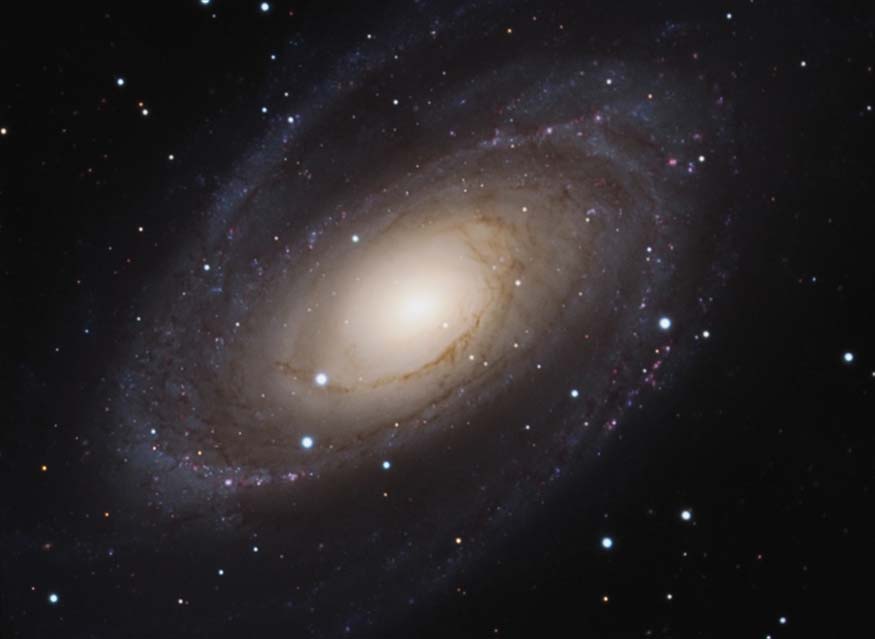
BEAUTY: 
BRAGGING RIGHTS: A beautiful sight
HOW EASY IS IT TO SEE? Best with a small telescope
BEST TIME TO SEE IT: Spring (in Ursa Major)
TYPE: Galaxy
DISCOVERED: 1774 by Johann Elert Bode
In 1774, amateur-astronomer-turned-professional Johann Bode discovered two nebulous objects close together near the Big Dipper. He had no idea what they were. But neither did anyone else, so Bode added them to his catalog of nebulous objects and carried on. Charles Messier read about them and added them to his own catalog as Messier 81 and Messier 82.
Eventually, Messier 81 (M81) was revealed to be a giant spiral galaxy near our own Milky Way. M82 was also identified as a galaxy, but many mysteries remained. In particular, why did it look like it was exploding? In 1963, astronomers took high-resolution images of M82 and determined that the gaseous filaments seen in the photo were flying out of the center of M82 at more than 500 kilometers per second.
At first astronomers suspected M82 had a violent nucleus, like those seen in quasars and active galaxies like M77. Instead, it turned out Bode’s other discovery was to blame: its big brother, M81, was causing M82 to act up.
Millions of years ago, M81 and M82 flew past each other in their long, lazy orbits. The larger galaxy, M81, rattled the smaller one as it flew past, like a speeding truck disturbing a puddle on the side of the road. Density waves—shock waves caused by M81’s massive gravity—sloshed inside of M82 and compressed gas near its core. The gas condensed and created thousands and thousands of new stars—a stellar baby boom. Millions of years later, those stars began to reach the end of their lives, and just as they were born together, they died together. Thousands of supernovas exploded in a (relatively) brief period of time, and the collective blast from all those explosions streamed out of the core.
MESSIER 82
Finding M81 and M82 is not easy; they aren’t near any obvious bright star. The easiest way is probably to use the Big Dipper as a guide. Draw a line from Phecda to Dubhe (see chart on next page) and keep following that line for about the width of the Dipper’s scoop. Now sweep with binoculars in that area and see if you can spot two fuzzy little objects.
M81 will be brighter and larger; and while M81 appears round, M82 will look elongated, like a ghostly cigar.
While binoculars let you see both objects at once, a small or medium telescope reveals much more detail. As always, dry, clear moonless nights are best for observing faint objects like these.
The core of M81. At moderate power you might see some detail in M81’s starlike core. Sharp edges in an otherwise smooth glow hint at spiraling dust clouds. Seeing any detail requires practice—a single glance is not enough. The photons from this vast galaxy are being sprayed out to the whole universe, and only a precious few are heading our way.
The arms of M81. Observe M81 at low power and see if you can trace the two spiral arms. They will be very faint and you will need to use averted vision, but persistence will be rewarded. Don’t expect to trace them all the way to their tip, as photographs show. Instead, see if you can at least distinguish them from the core.
Low power is essential: you want to concentrate the faint arms into a small area so they are bright enough to see.
M82. You won’t see the exploding filaments of M82 without a large telescope, but even at low power on modest instruments you can see some unevenness in this elongated galaxy. Perhaps you’ll notice some mottling or segments of unequal brightness.
Averted vision helps again to sense the fainter areas. Try to fit both M81 and M82 in the same field to get good contrast.
URSA MAJOR REGION IN SPRING; 30-DEGREE FIELD OF VIEW